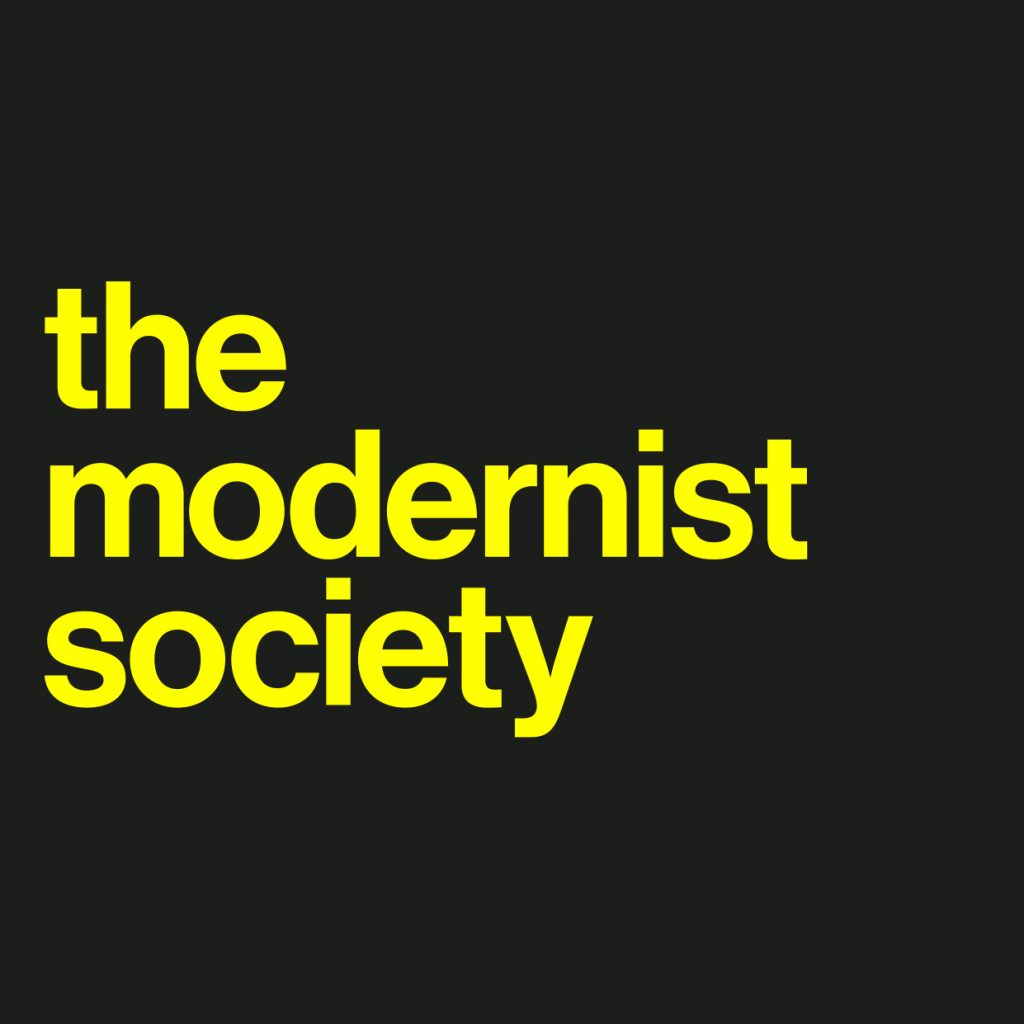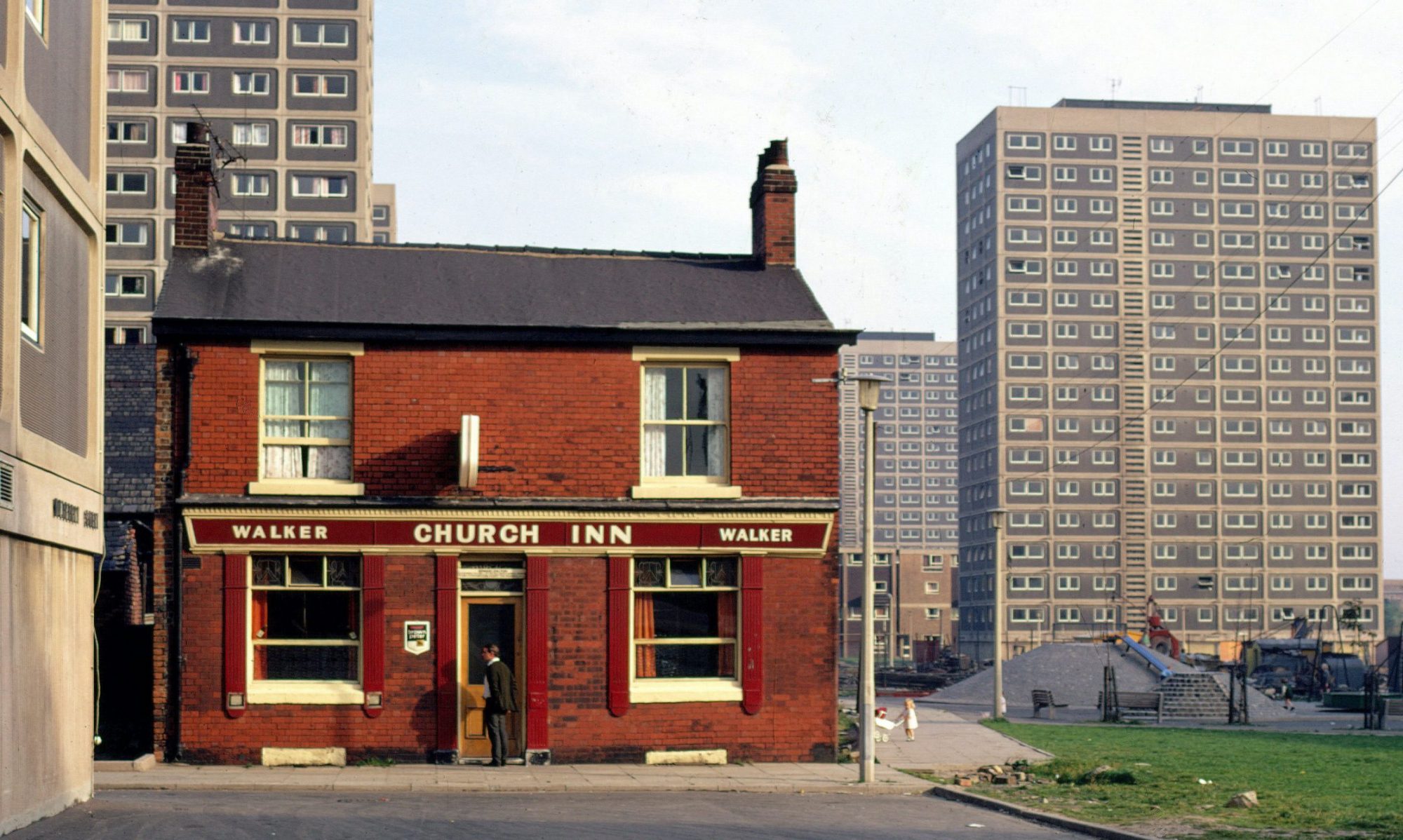The Modern Backdrop: Modern Architecture and Communities in Salford
In November 2019 the University of Salford held a public 50th anniversary screening of Michael Goodger’s documentaries “The Changing Face of Salford” and “Salford: The Other Side” filmed between 1968 and 1970 when terraced housing was in the process of being replaced with modern high-rise buildings and a shopping centre.
Goodger depicted the living environments and focussed on the poor conditions of houses without electricity, bathrooms, and hot water. Many former residents of the areas filmed were in the audience and the film screening ignited a discussion that touched on a nostalgia for lost communities, memories of being ‘rehoused’ and sparked annoyance about being portrayed as slum dwellers.
Former residents of Salford ‘slums’ vehemently rejected the depiction of their living conditions in Goodger’s documentaries. This clear discrepancy between the depiction of living conditions with how they are remembered today is the focus of this research project and the exhibition will showcase its findings.
During this two-year project we want to analyse the transition of Salford from terraced housing, via slum clearance, to modern social housing projects from the late 1950s to the early 1970s. The project is a collaboration between the Modernist Society, the RIBA NW and the University of Salford. It is funded by the Paul Mellon Centre for Studies in British Arts. Apart from this website and regular blog posts, we will organise a range of events that will also be announced on this website. The events showcase the transition of Salford during the 1960s and 70s and we are hoping to enthuse long-term residents to attend and give us their comments and memories of that time.
At the end of the project, an exhibition will juxtapose stakeholders and architects’ interpretations and aspirations for working-class social housing and contemporaneous depictions of Salford in film, photography and literature with memories of this transition. The exhibition aims to showcase how stakeholders and architects planned for the future inhabitants of tower blocks and how new and old housing and residents of Salford were depicted in a range of media. This will help to understand if/how external agents helped form a perception of Salford residents. The final step is to compare findings with material and memories collected from long-term residents.
Salford is an appropriate case study for this investigation as its modern transformation was among the most radical ones in the UK in that a great percentage of the pre-existing urban landscape was replaced with modern housing projects leaving almost no points of references in the new urban fabric. Terraced housing was replaced with more than 30 high rise apartment blocks and a shopping centre in the borough of Pendleton.
The modernisation was initiated due to a continuing decline of the economy and population caused by the diminution of the textile industry that, since the Industrial Revolution, had mainly fuelled Salford’s industrialisation and growth. Salford was left with high-density, poor-quality terraced housing (up to 80 homes per acre) that as early as in 1931 had been deemed a slum. The large-scale transformation of Salford was, as with many British cities, enabled by the Slum Clearance Compensation Act (1965) and the Housing Subsidies Act (1967).
At the same time, the slums of Salford also became the backdrop in a variety of media. Early episodes of the TV drama ‘Coronation Street’ juxtaposed old and new Salford homes, Tony Richards 1961 adaptation of Shelagh Delaney’s 1958 play ‘A Taste of Honey’ was filmed partially in Salford to provide a context for the background of the protagonist. In the 1967 film ‘Charlie Bubbles’ Albert Finney and Liza Minelli drive a golden Rolls Royce through the abandoned terraces of Salford while the new modern tower blocks are visible in the background. Minelli takes photos of the people on the street as if documenting a world about to be lost. A similar impulse might have driven photographers such as Shirley Baker whose subject matter focussed on the lives on the streets and children playing. Robert Roberts 1971 book ‘The Classic Slum’ differs from these accounts in that he was an ‘insider’ and wrote about his experiences while growing up in Salford.
In juxtaposing the aspirations of those planning the transformation of Salford (as expressed in policies, Clearance Act, reports, surveys, architectural plans, etc.) with depictions of Salford as a working-class city with low housing standards, modes are hoped to be identified that contributed to the formation of the identity of a ‘Salford resident’.
With the help of this website and several events we are looking to engage residents of Salford to share their memories, photographs, etc. so that we can understand the differences in how residents remember the transition from living in terraced houses to modern ones past and how it was depicted in the media.
Meet the Team

Dr Alex Mitchell is the Archivist at the University of Salford and it is my job to look after the historic records about the University, as well as a number of ‘Special Collections’ on various themes including brass bands, the Duke of Bridgewater (builder of the Bridgewater Canal) and the manuscripts of the Salfordian Walter Greenwood. Through family connections and working in the area for several years, I am really interested in Salford’s history and identity. As part of the Modern Backdrop project, I’ll be delving into the archives to piece together the story of how the built environment of Salford changed in the third quarter of the twentieth century and how the official records contrast with the real lived experiences of the people in the area.

The Modernist Society is dedicated to celebrating and engaging people with twentieth century architecture and design, through publishing, events, exhibitions and creative collaborations. the modernist society was originally founded as The Manchester Modernist Society in 2009 and is a creative community, organising tours, lectures and gatherings. There are currently Chapters in Manchester, Sheffield, Liverpool, Birmingham Leeds and Swansea.
Our publishing arm was established in 2011 with the modernist magazine. It has now developed into a small press, publishing limited editions about 20th century architecture and design.

Dr Tanja Poppelreuter is a Reader in Architectural Humanities at the University of Salford, Manchester. Her research interests lie in the field of 20th-century art and architecture with a focus on the perceptions and development of architectural space, social housing, and women in 20th-century architecture.
She has published on refugee architects to New Zealand and to the United States, discussed ambitious projects to modernise Baghdad during the 1950s, analysed spatial configurations developed by well-known modernist architects such as Walter Gropius and Ludwig Mies van der Rohe and is the editor of the book Glamour and Gloom that discusses the modern architecture of the 1930s in Belfast.In addition to this, she leads the project “The Modern Backdrop” (https://hub.salford.ac.uk/modern-salford/) funded by the Paul Mellon Centre. Tanja also is a member of the Strategic Planning Committee of the US-based Society of Architectural Historians (SAH) and of the Equality, Diversity and Inclusivity (EDI) group of the RIBA North West.

RIBA North West represents over 4,000 Members and 300 Chartered Practices in the region. Our geographical area covers the entire North West, including Manchester, Liverpool, Chester, Blackpool, Lancaster, Carlisle, The Lake District National Park, and the Isle of Man.
The North West team works closely with a lively network of volunteers, partners and regional stakeholders, including universities and local authorities, to champion better buildings, communities, and environments through architecture. The North West Regional Council ensures the voice of our Members is heard regionally and nationally.
Our activities include recognising outstanding architecture through our awards programme, promoting the profession, and supporting our branches to deliver a range of events for Members across the region.

Professor Peter Walker is an architect and is Professor of Construction Science and Management and Head of Architecture at the University of Salford. Prior to joining the university Peter was Professor of Architecture and Head of the Belfast School of Architecture at Ulster University; a director of a large health care practice – Devereux Architects; and taught part time at Newcastle University. Before that he was Project Director of the international design consultancy Conran Design Group, headed by Sir Terence Conran.
Professor Walker has been an independent advisor to the Architects Registration Board and served for four years on the ARB Education and Practice Advisory Group. He has been an external examiner at ten UK universities and is on the Council of SCOSA (the Standing Conference of Schools of Architecture) where he heads the Ethical Practice Committee.
Peter has been a visiting Professor at two universities and is presently an RIBA Professional Examiner at Newcastle University. He was an adviser to the Egyptian Government Housing and Building Research Council in the development of the Green Pyramid Building Assessment Scheme, and he has acted as an expert witness on more than 70 cases of professional negligence in architecture. Peter is Impact Lead for UoA 13 in REF 2021.
He is the author or contributor to a number of academic papers and books, including most recently Contexts, a monograph of the award-winning Manchester architects, Hodder and Partners.
Contact us
For queries, comments etc please email: themodernbackdrop@salford.ac.uk


